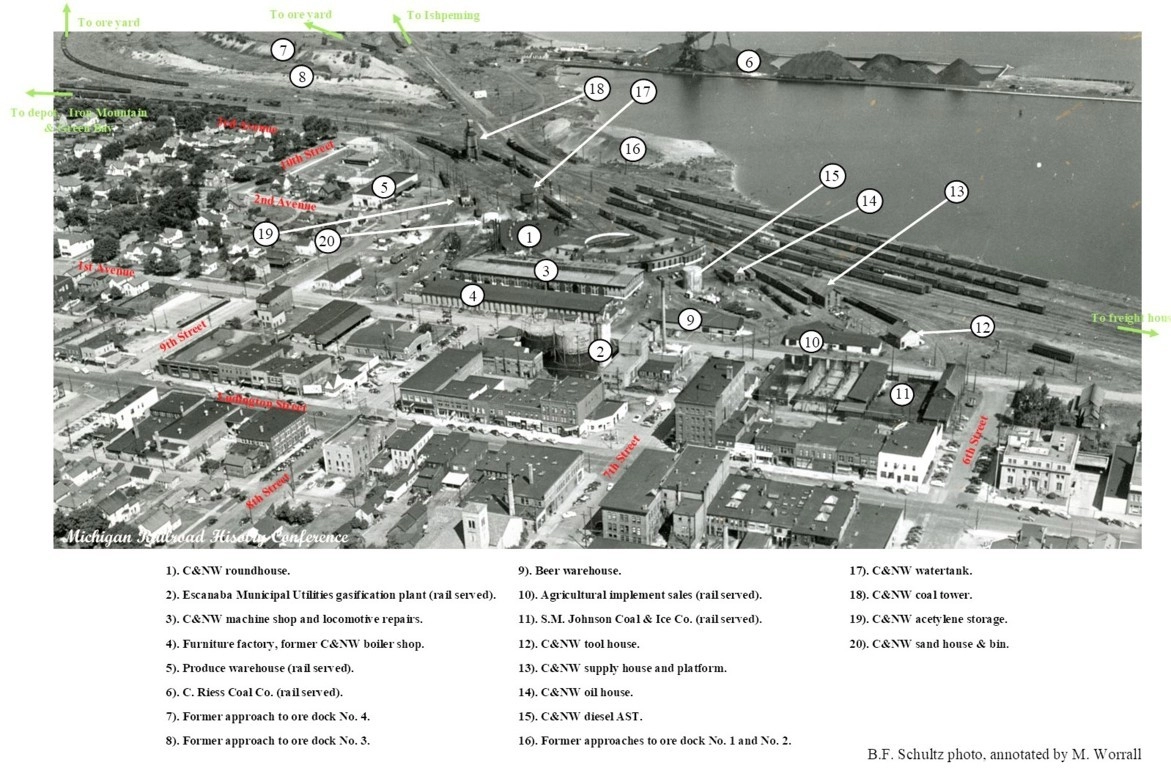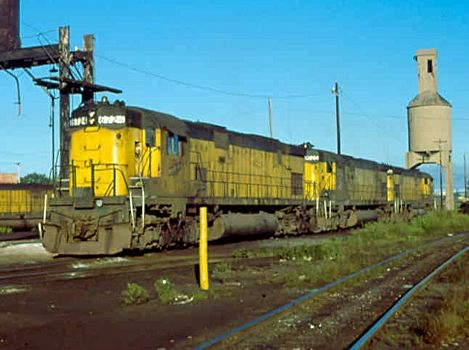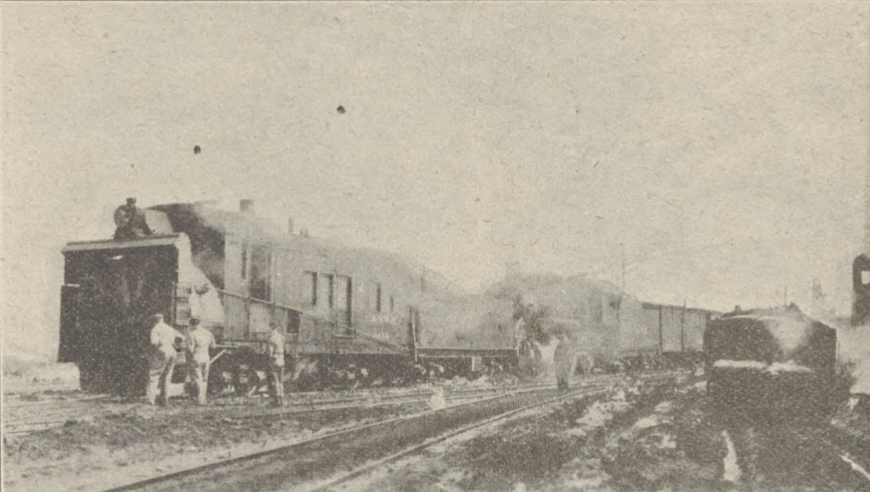- Details
- Hits: 6452
Location: Escanaba, MI - C&NW Facilities




The Chicago & North Western facilities in Escanaba were centered in four areas. The depot was located at the west side of what is now the downtown area and also co-located by the E&LS depot. Locomotive facilities were originally located on the north edge of downtown, near the coal transloading area along the lake. A concrete coaling tower is still located in this area but abandoned. The third area was the ore docks and ore loading facility along the bay north of downtown. This facility also had a large "ore yard" west of here. The 4th area was the C&NW shops and engine service facility, which is still located by the fairgrounds and used by the E&LS and other industry.
Photo info: Top, an overhead view of the C&NW facilities as Escanaba. [Mark Worrall collection]. 2nd and 3rd photos, the C&NW engine facility in downtown Escanaba. The top and bottom photos show the concrete coaling tower, which continues to exist in 2014. The bottom photo shows the turntable which was formally used to turn steam locomotives. These 6-axle Alco diesel electric locomotives powered ore trains between Negaunee and the ore docks at Escanaba during the 1960's and 1970's. [Charlie Whipp] 4th photo, an old 1917 view of a C&NW rotary snow plow ready to leave Escanaba shops for the Whitefish Valley Branch (Winde to Lagota). [CLM-1917]
Notes
The C&NW had major facilities at Escanaba. The railroad had a large repair facility and a tie-treating plant. 750 men were employed her by the railroad in the late 1800's. The roundhouse was completed in 1869 with fifteen original stalls. By 1890 the roundhouse had nineteen additional stalls, probably built before 1881. In addition to the roundhouse, there was also a 30' by 300' brick machine shop, and a 60' by 300' blacksmith shop. The roundhouse was reduced in size in 1952 and again in 1961 leaving only six stalls. The roundhouse had an outside diameter of 200'. It was a wood frame structure except for one interior wall intended as a fire wall. The turntable was 12' wide and 95' long. [UPM]
Time Line
1916. C&NW builds a new turntable at Escanaba. [MCR-1916]
1949. The Escanaba fire department was called at 3:00 a.m. to the depot at Escanaba, to give water to supply heat in the coaches of the C&NW streamliner. The streamliner generally gets water for the heating unit at Green Bay and Negaunee, but ran low when stopped at Escanaba. [EDP-1949-1224]
1940s. A new coaling plant and multiple track ash handling plant opens at Escanaga. It has a 150 ton capacity and replaces the old trestle-type plant which was built in the 1880's. Coal is dumped from cars into a hopper at the new plant and elevated to the top of the 75-foot tower where it is dumped into a storage bin. Two locomotives can load at the same time.
The new ash handling [lant replaces the old type cinder pit. The new plant draws ashes from the pit, elevates them and dumps them into a car for hauling away.
1954. December. A new diesel switch engine and a general purpose diesel powered locomotive were put into operation here Thursday. The switcher is rated at 1,200 horsepower, the general purpose engine at 1,750. The Gladstone division will be completely dieselized by mid-January. Two more general purpose locomotives are scheduled to come here, one to work east of Gladstone, the other west while one will be for standby. Another type of locomotive rated at 1,000 horsepower is also scheduled for delivery here and will be used on the Rapid River branch of the Soo Line which runs from Rapid River to Eben Junction. [EDP-1954-1231]
1961. One of Escanaba's oldest structures, the Chicago & North Western railway's roundhouse whose history dates back to 1865 is being torn down in part because of its age and the fact that changing times have ended its usefulness. Four stalls of the roundhouse were torn down eight or nine years ago, and today 17 stalls and 10 tracks are being removed by a contractor. This will leave a portion of a roundhouse containing six stalls with tracks, plus about six tracks in the area without roofs. [EDP-1961-1018\
Car Knockers OK Bad Orders - 1947
C&NW Rip Yards Make Good Ones Out Of Bad For Coming Season
Three thousand of the C&NW's chunky red ore cars have gone through the car repair yard at the foot of North Twelfth street in Escanaba since the ore season closed last fall.
Operating under General Car Foreman C. T. Weir, the repair yard with a force of 63 men has this winter made heavy and light repairs to very nearly all the ore cars on the Peninsula division in addition to some 300 ore cars belonging to the Milwaukee Road and operated on the Peninsular division under the ore-pooling agreement. Regular running repairs of course, were given all cars whenever necessary, box, gondola, flat domestic or foreign.
Repairs on the Milwaukee Road's ore cars are handled under the American Railroad Association's rules, with the work done by the C&NW's Escanaba repair yards and the bill therefore sent on to the Milwaukee Road. Four hundred of the CMStP7P cars are being repaired at the Milwaukee Road's shops at Green Bay.
With about 20 heavy repairs yet to make - replacement of heavy steel plates - and perhaps 40 light, the Escanaba yards are nearly caught up on their annual job. But already 4 ore cars which were used in the rail-ore shipments to Alabama have come back to Escanaba, riding not on their own wheels, but on flat-cars, damaged in a derailment on the Illinois Central. Perhaps 12 more of the first such ore cars to be ventured further south than Escanaba, are expected back in a damaged condition, due to derailments on foreign roads.
On April 1, the annual overhaul and repair job done, General Foreman Weir's men will turn to the summer painting job. Each ore car is scraped, wire-brushed, sprayed with red paint, and then paint-sprayed, and the stenciling on in white over that. The stenciling in addition to the initials and the number of the car, indicates the light weight, the load limit, the capacity, the type of draft gear, of brake beam, and the cubic capacity of the car.
Painting will continue until November 1 when bad weather makes it impossible in the shelter-less Escanaba repair yards. [EDP-1947-0326]
Bibliography
The following sources are utilized in this website. [SOURCE-YEAR-MMDD-PG]:
- [AAB| = All Aboard!, by Willis Dunbar, Eerdmans Publishing, Grand Rapids ©1969.
- [AAN] = Alpena Argus newspaper.
- [AARQJ] = American Association of Railroads Quiz Jr. pamphlet. © 1956
- [AATHA] = Ann Arbor Railroad Technical and Historical Association newsletter "The Double A"
- [AB] = Information provided at Michigan History Conference from Andrew Bailey, Port Huron, MI

